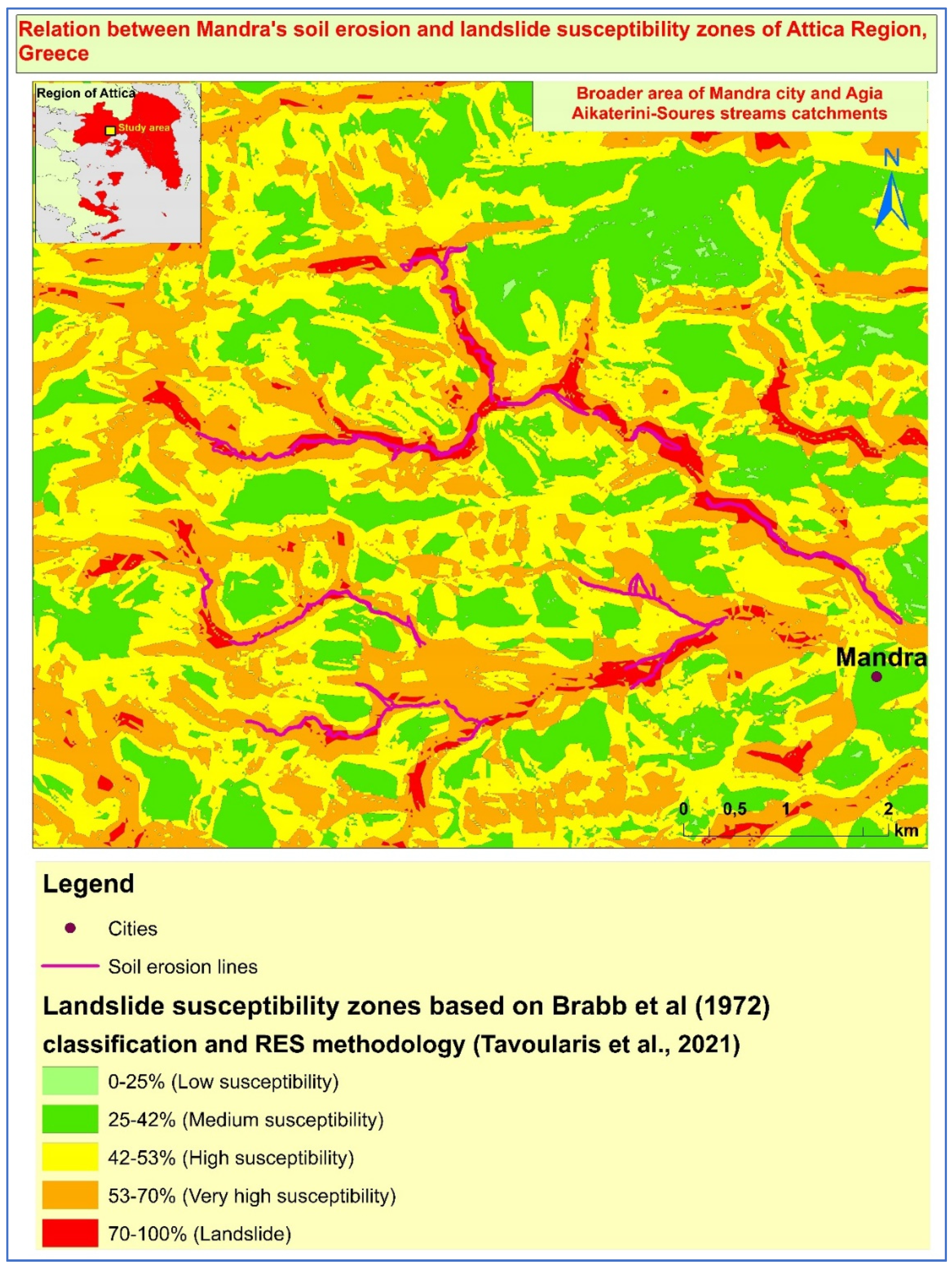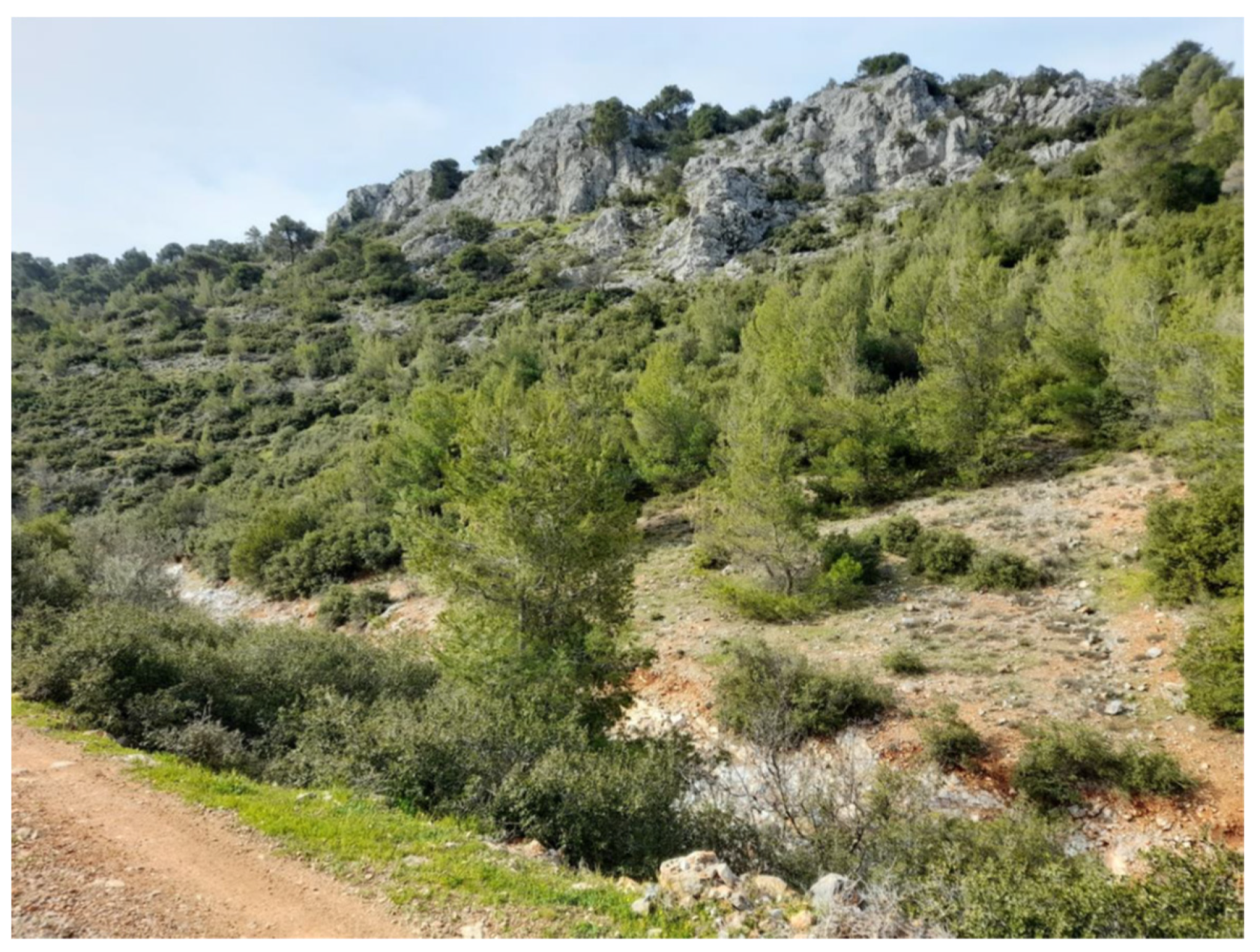Submitted:
11 August 2023
Posted:
14 August 2023
Read the latest preprint version here
Abstract
Keywords:
1. Introduction
2. Materials and Methods
2.1. Location of the study area
2.2. The fatal flash flood event of Mandra (11/2017)
2.3. Geological setting
2.4. Causes of the Mandra flood
2.5. Soil erosion - Erodibility
2.5.1. Surface (sheet) erosion
2.5.2. Rill erosion
2.5.3. Gully erosion
2.5.4. Slope and sub-slope erosion (Riverbank erosion)
2.6. Modelling of Soil Erosion
2.6.1. Susceptibility to soil erosion
2.6.2. Rock Engineering System (RES) methodology
2.6.3. Mapping performance evaluation.
3. Results and discussion
- a reduction in the amount of solid material transported, with a corresponding reduction in the erosive capacity of the flood waters and the volume of the flood wave.
- The velocity of the flood wave is reduced, resulting in a delay in its occurrence downstream and a reduction in its destructive momentum.
- The effects of erosion on unprotected soils are reduced.
- The natural environment is protected and enhanced, especially through planting and soil protection projects.
- Construction of small dams to grade the bed and retain the slopes
- Construction of dams for the retention of debris
- Construction of culverts in places where the existing road network is eroded by streams in the study area
- Settlement of part of the hydrographic network of the study area by constructing an artificial bed with a dike
- Implementation of horticultural works
- Forestry measures for the management of the overall forest complex in the study area
- Opening of forest roads to reach the sites of the proposed projects
- (a)
- Construction of sediment barriers are intended to be between 3m and 8m high with reinforced concrete or unreinforced concrete construction material. The purpose of these dams is to counteract the axial erosion of the bottom of the stream bed, by reducing the drag force of the water and retaining the sediment.
- (b)
- Construction of graduation dams - slope stabilization: These dams are proposed to be made of concrete (reinforced or unreinforced) or of reinforced wire mesh (e.g., sarsenet). The construction of the dams will be carried out either in places where there is evidence of gradual erosion, or in places where there is axial erosion of the bottom of the bed, in combination with the above-mentioned sediment barriers. The height of these dams according to the theoretical assessment carried out, is proposed to be between 1m and 2m.
4. Conclusions
Funding
Acknowledgments
Conflicts of Interest
References
- Borrelli, P.; Poesen, J.; Vanmaercke, M.; Ballabio, C.; Hervás, J.; Maerker, M.; Scarpa, S.; Panagos, P. Monitoring gully erosion in the European Union: A novel approach based on the Land Use/Cover Area frame survey (LUCAS). Int. Soil Water Conserv. Res. 2021, 10, 17–28. [Google Scholar] [CrossRef]
- Panagos, P.; Van Liedekerke, M.; Jones, A.; Montanarella, L. European Soil Data Centre: Response to European policy support and public data requirements. Land Use Policy 2012, 29, 329–338. [Google Scholar] [CrossRef]
- Senanayake, S.; Pradhan, B.; Huete, A.; Brennan, J. A Review on Assessing and Mapping Soil Erosion Hazard Using Geo-Informatics Technology for Farming System Management. Remote. Sens. 2020, 12, 4063. [Google Scholar] [CrossRef]
- Karydas, C.G.; Panagos, P.; Gitas, I.Z. A classification of water erosion models according to their geospatial characteristics. Int. J. Digit. Earth 2012, 7, 229–250. [Google Scholar] [CrossRef]
- Teng, H.; Liang, Z.; Chen, S.; Liu, Y.; Rossel, R.A.V.; Chappell, A.; Yu, W.; Shi, Z. Current and future assessments of soil erosion by water on the Tibetan Plateau based on RUSLE and CMIP5 climate models. Sci. Total. Environ. 2018, 635, 673–686. [Google Scholar] [CrossRef] [PubMed]
- Panagos, P.; Borrelli, P.; Poesen, J.; Ballabio, C.; Lugato, E.; Meusburger, K.; Montanarella, L.; Alewell, C. The new assessment of soil loss by water erosion in Europe. Environ. Sci. Policy 2015, 54, 438–447. [Google Scholar] [CrossRef]
- Senanayake, S.; Pradhan, B.; Huete, A.; Brennan, J. Assessing Soil Erosion Hazards Using Land-Use Change and Landslide Frequency Ratio Method: A Case Study of Sabaragamuwa Province, Sri Lanka. Remote. Sens. 2020, 12, 1483. [Google Scholar] [CrossRef]
- Batista, P.V.; Davies, J.; Silva, M.L.; Quinton, J.N. On the evaluation of soil erosion models: Are we doing enough? Earth-Science Rev. 2019, 197. [Google Scholar] [CrossRef]
- Gholami, V.; Sahour, H.; Amri, M.A.H. Soil erosion modeling using erosion pins and artificial neural networks. CATENA 2021, 196, 104902. [Google Scholar] [CrossRef]
- Cohen, M.J.; Shepherd, K.D.; Walsh, M.G. Empirical reformulation of the universal soil loss equation for erosion risk assessment in a tropical watershed. Geoderma 2005, 124, 235–252. [Google Scholar] [CrossRef]
- Huang, F.; Chen, J.; Du, Z.; Yao, C.; Huang, J.; Jiang, Q.; Chang, Z.; Li, S. Landslide Susceptibility Prediction Considering Regional Soil Erosion Based on Machine-Learning Models. ISPRS Int. J. Geo-Inf. 2020, 9, 377. [Google Scholar] [CrossRef]
- Rozos, D.; Skilodimou, H.D.; Loupasakis, C.; Bathrellos, G.D. Application of the revised universal soil loss equation model on landslide prevention. An example from N. Euboea (Evia) Island, Greece. Environ. Earth Sci. 2013, 70, 3255–3266. [Google Scholar] [CrossRef]
- Abdulkareem, J.; Pradhan, B.; Sulaiman, W.; Jamil, N. Prediction of spatial soil loss impacted by long-term land-use/land-cover change in a tropical watershed. Geosci. Front. 2019, 10, 389–403. [Google Scholar] [CrossRef]
- Persichillo, M.G.; Bordoni, M.; Meisina, C. The role of land use changes in the distribution of shallow landslides. Sci. Total. Environ. 2017, 574, 924–937. [Google Scholar] [CrossRef] [PubMed]
- Gunatilaka, A. Role of basin-wide landslides in the formation of extensive alluvial gemstone deposits in Sri Lanka. Earth Surf. Process. Landforms 2007, 32, 1863–1873. [Google Scholar] [CrossRef]
- Pradhan, B.; Chaudhari, A.; Adinarayana, J.; Buchroithner, M.F. Soil erosion assessment and its correlation with landslide events using remote sensing data and GIS: a case study at Penang Island, Malaysia. Environ. Monit. Assess. 2011, 184, 715–727. [Google Scholar] [CrossRef]
- Meena, S.R.; Ghorbanzadeh, O.; Blaschke, T. A comparative study of statistics-based landslide susceptibility models: A case study of the region aected by the gorkha earthquake in Nepal. ISPRS Int. J. Geo-Inf. 2019, 8, 94. [Google Scholar] [CrossRef]
- Tavoularis, N.; Papathanassiou, G.; Ganas, A.; Argyrakis, P. Development of the Landslide Susceptibility Map of Attica Region, Greece, Based on the Method of Rock Engineering System. Land 2021, 10, 148. [Google Scholar] [CrossRef]
- Regional Authority of Attica/Directorate of Technical Works, H.S.G.M.E., 2018. Integrated geological survey for the reduction of flood risk in the wider region of Mandra, Attica – Measures for the prevention and mitigation of flooding phenomena (Greek Geological Institute and Mining Research (H.S.G.M.E.) – Deliverable ΙΙ (unpublished).
- COPERNICUS - Emergency Management Service – Mapping. EMSR257: Flood in Attika, Greece. Available online: https://emergency.copernicus.eu/mapping/list-of-components/EMSR257/ALL/EMSR257_01MANDRA.
- Lekkas, E.; Voulgaris, N.; Lozios, S. (2017). Flash Flood in West Attica (Mandra, Nea Peramos) , 2017. Newsletter of Environmental, Disaster and Crisis Management Strategies Issue No 5, Hellenic Republic National & Kapodistrian University of Athens. https://edcm.edu.gr/images/docs/newsletters/Newsletter201705_Mandra-Floods-eng.pdf. 15 November.
- Li, Y.; Mo, P. A unified landslide classification system for loess slopes: A critical review. Geomorphology 2019, 340, 67–83. [Google Scholar] [CrossRef]
- Blasche, P. M, Trustrum N. A., Hicks D.L. Impacts of mass movement erosion on land productivity: A review. Prog. Phys. Geogr. Earth Environ. 2000, 24, 21–52. [Google Scholar]
- Ayanlade, A.; Jegede, M.O.; Borisade, P.B. Geoinformatics in eco-climatic studies. In Encyclopedia of Information Science and Technology, 3rd ed.; Information Resources Management Association: Hershey, PA, USA, 2014; pp. 3136–3144. [Google Scholar]
- Dang, K.; Sassa, K.; Konagai, K.; Karunawardena, A.; Bandara, R.M.S.; Hirota, K.; Tan, Q.; Ha, N.D. Recent rainfall-induced rapid and long-traveling landslide on 17 May 2016 in Aranayaka, Kagelle District, Sri Lanka. Landslides 2018, 16, 155–164. [Google Scholar] [CrossRef]
- Greece Republic, Region of Attica, Directorate for flood protection works, Hydroment Consulting Engineers S.A. - Kritsotakis G. (2021). Delimitation, settlement and damming of the Soures and Agia Aikaterini streams north of the town of Mandra. Unpublished technical report.
- Hudson, J. , 1992. Rock Engineering Systems: Theory and Practice. Ellis Horwood Limited: Chichester.
- Hudson, J. A Review of Rock Engineering Systems (RES) Applications over the Last 20 Years; Department of Earth Science and Engineering, Imperial College: London, UK, 2013. [Google Scholar]
- Tavoularis, N.; Koumantakis, I.; Rozos, D.; Koukis, G. An implementation of rock engineering system (RES) for ranking the instability potential of slopes in Greek territory. An application in Tsakona area (Peloponnese - prefecture of Arcadia). Bull. Geol. Soc. Greece 2017, 49, 38. [Google Scholar] [CrossRef]
- Tavoularis, N.; Koumantakis, I.; Rozos, D.; Koukis, G. The Contribution of Landslide Susceptibility Factors Through the Use of Rock Engineering System (RES) to the Prognosis of Slope Failures: An Application in Panagopoula and Malakasa Landslide Areas in Greece. Geotech. Geol. Eng. 2017, 36, 1491–1508. [Google Scholar] [CrossRef]
- Brabb, E.; Bonilla, M.G.; Pampeyan, E. Landslide Susceptibility in San Mateo County, California. US Geological Survey Miscellaneous Field Studies, Map MF-360, Scale 1:62,500; US Geological Survey: Reston, VA, USA, 1972. [Google Scholar]
- Varnes, D. ; IAEG Commission on Landslides and Other Mass-Movements. Landslide Hazard Zonation: A Review of Principles and Practice; UNESCO Press: Paris, France, 1984; 63p. [Google Scholar]
- Gunther, A.; Reichenbach, P.; Wilde, M.; Jurchescu, M.; Malet, J.P.; Hervas, J. (2022). New perspectives on the Europe-wide landslide susceptibility assessment (ELSUS). 2nd EU Soil Observatory Stakeholders Forum, 24-, online. 26 June.
- Reichenbach, P. , Gunther A, Rossi M. (2022). Susceptibility to mass movements at different scales. 2nd EU Soil Observatory Stakeholders Forum, 24-, online. 26 June.
- Tavoularis, N. (2022). Soil erosion and landslide susceptibility mapping using Rock Engineering System methodology. The case of Mandra fatal flash flood (2017) in Western Attica, Greece. 2nd EU Soil Observatory Stakeholders Forum, 24-26 June 2022, online (https://esdac.jrc.ec.europa.eu/euso/presentations-2nd-euso-stakeholders-forum).









Disclaimer/Publisher’s Note: The statements, opinions and data contained in all publications are solely those of the individual author(s) and contributor(s) and not of MDPI and/or the editor(s). MDPI and/or the editor(s) disclaim responsibility for any injury to people or property resulting from any ideas, methods, instructions or products referred to in the content. |
© 2023 by the authors. Licensee MDPI, Basel, Switzerland. This article is an open access article distributed under the terms and conditions of the Creative Commons Attribution (CC BY) license (http://creativecommons.org/licenses/by/4.0/).




